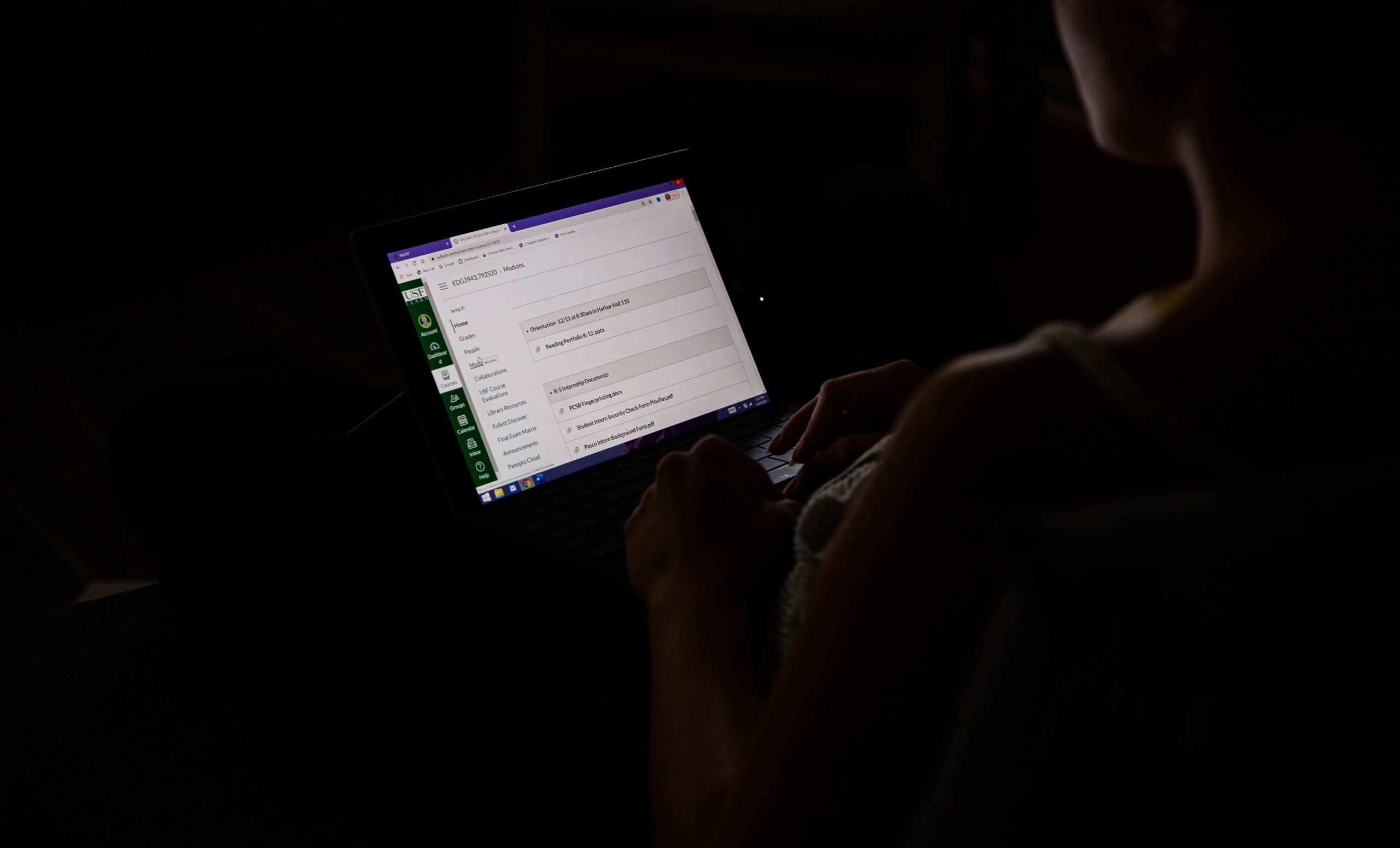Pictured above: Students and faculty across the USF system are working out the best way to approach an online education during the coronavirus pandemic.
Thomas Iacobucci | The Crow’s Nest
By James Bennett III
As people around the world adjust to life during a pandemic, students and faculty at USF St. Petersburg have begun to face the challenges of remote education.
Students like Jessica Figueroa, a senior geospatial analysis and geography major, have found the transition particularly difficult.
Without a laptop or WiFi, her assignments piled up during the first week of remote classes. Some of her professors were even assigning more work than usual to compensate for lost face-to-face interactions.
“I’ve lived in my house for 11 years,” Figueroa said. “I’ve raised my daughter without internet or cable because there were always alternative options.”
Eventually, Figueroa was able to borrow a laptop from the university’s library and secure 60 days of free WiFi from Spectrum, but she still has to worry about buying food while she has money tied up in a campus meal plan she can’t use.
Figueroa also said communication with USF’s financial aid and advising departments have been slow at best. To her, Student Outreach and Support has been the most responsive.
“It’s not fair,” Figueroa said. “It’s got me questioning, ‘Do I even want to finish school? Or do I just want to go get a couple of jobs so I can survive?’”
Verna Peddi, a senior anthropology and sociology student, said her first week of online classes went smoother than she expected.
Peddi has already had a career in information technology working for Gateway, Inc. and Lockheed Martin.
“Typically, when you establish a new software, or what have you, you’re going to expect some issues. It’s not unusual,” Peddi said. “But I have to say, truthfully, that my classes on Monday went exceptionally well for this being put together in a short amount of time.”
Peddi said most of her classes used a feature on Canvas called Blackboard Collaborate Ultra, a video conference software that lets people interact with documents and send messages.
“I didn’t really feel there was a big difference, because the information was the same,” Peddi said.
So far, Peddi said the only problem she had with the software was being kicked off a conference call during her Gender and Cross Cultural Perspective class.
“I don’t know what kind of bandwidth we’re working with, but I didn’t notice anyone else say anything about being knocked off,” Peddi said.
Professors are also getting used to the change.
David Watts, a graphic design instructor, has taken an asynchronous approach with the classes he teaches.
Instead of setting up conference calls, Watts has been making videos that accompany assignments.
Watts said it takes him roughly two hours to film, process and upload each video, but a lot of students have already messaged him to say they appreciate his effort.
There are still challenges to teaching graphic design remotely, though.
For example, Watts said, there have been some problems with Microsoft Teams, a platform that lets students and professors collaborate remotely. Some students discovered that their web browser wasn’t compatible with the platform’s video calls, while others couldn’t even sign on.
Since the campus is closed, students have also lost access to the equipment stored in Harbor Hall, where the graphic design program is housed.
Every week, since about one month before spring break, students in Watts’ Advanced Graphic Design class have been creating three new objects they’re able to mass-produce and sell on personal websites — Watts used stickers, decals and chairs as possible examples.
But since some students no longer have access to things like sticker paper or a vinyl cutter, Watts has modified assignments to allow those students to outsource their production.
“You need to learn how to use your resources or how to research for yourself,” Watts said. “But the goal is, to me, to give the information that I’ve had over a career and pass that on to them in a way that they would have otherwise never gotten unless they had the career for themselves.”
In general, Watts said subjects like web development are better suited for face-to-face classes, where he’s able to answer questions more rapidly and address the entire class more easily.
Leon Hardy, a physics professor and the campus’ physics lab director, prefers face-to-face classes as well. For the first time in his 20-year career as a professor, he has been teaching his classes online.
Now, instead of lecture demonstrations about optics and “getting their hands dirty” with an experiment in the lab, students in the physics program are missing out on what Hardy considers key educational experiences.
Hardy said he has been assigning discussion posts on Canvas and adding more questions to his scheduled tests to make up for the lack of in-person interaction. Although he doesn’t teach the lab classes directly, he has also provided data to analyze in lieu of access to physical experiments.
“You miss all of the things that you have when you’re right next to somebody,” Hardy said. “If you’re right next to somebody, it’s a lot more meaningful — at least to me — than doing it this kind of ghost way.
“I’m frustrated, the students are frustrated, and there’s nothing I can do.”
This story was updated on April 10, 2020.



